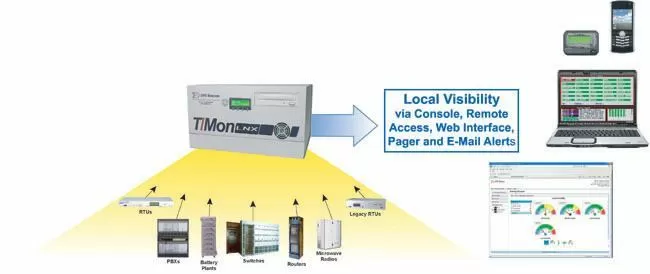Download our free Monitoring Fundamentals Tutorial.
An introduction to Monitoring Fundamentals strictly from the perspective of telecom network alarm management.
1-800-693-0351
Have a specific question? Ask our team of expert engineers and get a specific answer!
Sign up for the next DPS Factory Training!

Whether you're new to our equipment or you've used it for years, DPS factory training is the best way to get more from your monitoring.
Reserve Your Seat TodayThin Client Basics
A thin client is any computer hardware or software that depends on another system to perform its computing tasks in a server-client architecture. The thin client provides access to the server, but relies on the server to do all the work.
You generally see thin clients employed in large networks, where users all need access to the same resources, because thin clients have a net effect of simplifying the network. The server provides the single point of thought and access, reducing the number of variables - things that could go wrong - on the network. With thin clients, all accessing the same files simultaneously, you don't have to worry if you're working with outdated data because someone else has the file open and is working on it locally. All you have to worry about is the ability to contact the server and that the file is on the server. That's it.
The same principles apply to software-based thin clients. They simply provide you an interface to work with data remotely. Again, this increases security, reduces cost, and simplifies maintenance tasks.
Thin Client Architecture Applied for Network Management
Thin clients provide the advantages network management professionals are looking for, to help simplify and maintain burgeoning network resources. With thin clients, you can increase network visibility and get easier access to the information you need to keep your networks on a tight leash.
Adding remote telemetry devices like the NetGuardian series to your network allows multiple users to access the same data remotely over a thin web-based client. With these units, you can access critical data about your site and operate controls remotely, without "fat" software. From any compatible internet browser, you can checkup on your sites and be sure you have a legitimate problem before you roll a truck on it.
These telemetry units can also notify and receive acknowledgement via SMS and e-mail, so any technician, equipped with only a smartphone, can take care of business.
Thin Client Network Management Applied on a Larger Scale
On an even larger scale, alarm managers like the T/Mon LNX, allow you remote access to an entire network of remote telemetry units, providing comprehensive visibility for your whole network. The telemetry units report directly to T/Mon, which then acts as a single point of access for your network monitoring data, allowing you both local and remote access. You won't have to staff your NOC center 24/7/365, now that your technicians can simultaneously access available network data through thin web, virtual, or map-based clients.

T/Mon LNX also alerts you when alarms occur, and since you can access the T/Mon remotely through any three of the thin clients, you don't have to drive to the NOC or the site to figure out what's going on, saving valuable time when alarms do occur.
Even from on-site, with access to the NOC, you can set and test derived controls and the reporting status of alarms, without requiring the aid of another technician at the NOC center. This frees up personnel and allows you to work independently and efficiently.
Thin clients make the network management easier by allowing instant and complete access to the server from anywhere, so you can get more done faster.
For more information on network monitoring servers, see The T/Mon LNX Remote Master